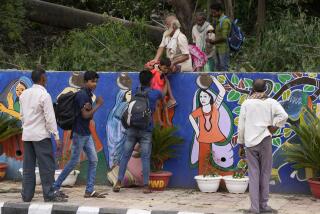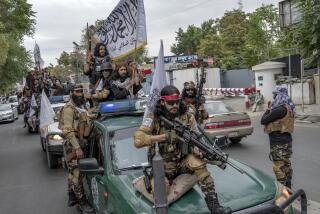India’s Largest City Is Ultimate Urban Nightmare : Calcutta Hits Rock Bottom of Black Hole
- Share via
CALCUTTA, India — A hundred years ago, Rudyard Kipling called it the “City of Dreadful Night,” and it is still the urban nightmare, the Black Hole of the 20th Century. Its name has become a synonym for urban apocalypse, a city in its death throes: Calcutta.
Home to 10 million people and India’s largest city, Calcutta is the compendium of the ills of the world’s cities. Once known as the city of palaces, it has become the city of problems, the textbook case of metropolitan gangrene that has defied cure.
The 200-year-old city, named after the bloodthirsty goddess Kali, once was the well-planned capital of British India until the government was moved to New Delhi in 1911. Calcutta now assaults the senses, evokes visceral reactions and conjures images, all true, of unfathomable poverty, slime and congestion.
Still it is known for the “Black Hole”--a dungeon where European prisoners suffocated from heat and jamming--and for potholes that some say are the world’s largest. It is notorious for generations of “pavement dwellers” who literally are born, reproduce and die on the sidewalks, and for lepers and deliberately maimed child beggars.
It is a city of labor wrangles and political clashes, of daily power blackouts--some lasting 12 hours--of mounds of stinking garbage, torturous traffic, acute water shortages and monsoon floods.
Proud Bengalis say reports of their great city’s demise are greatly exaggerated. Despite the filth, atrophy of services and trauma of daily life, they say it is a rich and dynamic center of the arts and millions of Calcuttans would live no place else.
The Metropolitan Development Authority, known as the “Digging Authority” for the torn-up streets, and citizens groups are trying to save it. There are projects for slum improvement, more water taps for sidewalk drinking and washing, power plants and a new subway.
City officials say the worst is over: The communist insurgency and industrial turmoil of the 1960s and 1970s are over, the population is stabilizing. In short, Calcutta has hit rock bottom and the only way to go is up.
But up is a long way off.
Calcutta remains the lurid case of near-total degradation of the human habitat, a failed equation between needs and resources. Simply, there are too many people and not enough food, water, latrines, houses, roads, transport, jobs, electricity and money. It is a city without open space, without room for roads, without enough pavement for sidewalk dwellers.
Better off than the street people are the rent-paying slum dwellers who live in sprawling hovels--wattle, sticks, metal sheets, mud, tiles, rags, plastic sheets--anything that can provide shelter.
The prognosis is dim since the economy of West Bengal state is stagnating, there is virtually no major new investment or growth, and many businesses and industries left over the years because of power trouble and labor unrest.
The city spends less than $7.80 per capita per year on services in the jammed central core of 3.3 million people, a pittance for what Kipling also called “a packed and pestilential town.”
Among the statistics:
--More than 10 million people are squeezed into 41.6 square miles with a citywide density of more than 13,200 per square mile.
--In the heart of Calcutta, about 80,000 people are packed into one square mile of vertical slum in Burra Bazar.
--In rambling slums known as bustees, there is a single water tap for each 125 people. About 700,000 such fortunate bustee dwellers have running water--an additional 300,000 have none.
--Hundreds of thousands of people--officially up to 200,000, unofficially 500,000--sleep, work or dwell on the pavement.
--Every day 2,500 tons or 5 million pounds of garbage accumulate in the streets. The city has only 250 decrepit garbage trucks, only 100 are running each day.
These mounds of stench mean life for dogs, pigs and chickens and a livelihood for pavement dwellers who pick through the refuse for re-salable rags, scraps of paper, bits of charcoal, tin cans. In the foulest slums, cattle are kept for milk and income and cow dung is precious for fuel, shaped into pancakes and left to dry on walls throughout the city. They are marked with the handprints of children.
--Only 6% of the urban area is road space, compared to 18% to 25% in other major cities. Of 1,200 city buses, only 550 to 600 are on the road each day. About 20% of them break down daily.
--At least 600 megawatts of electricity are needed daily but only 450 to 500 generated. Less than 45% of the generating capacity is used because of old or poorly maintained equipment and bad management. The hottest-selling consumer item--fast becoming a necessity--is the generator. When the power goes off, the city stops. During one blackout an electric safety valve failed to stop a leak of poisonous chlorine gas in a remote area.
Built for Million People
The causes of Calcutta’s decay are many. The most basic is that it was built for about a million people but services never kept pace with population growth.
The population was swollen by an influx of refugees from impoverished eastern India and Bangladesh after the 1971 war. There’s a saying that people go to Bombay to make money, to New Delhi to make a name and to Calcutta just to survive, many sending their meager remittances out of the city.
Calcutta planners debate which problem is worse--lack of power, lack of housing, lack of water.
The basic philosophy is not to bulldoze and start anew, but to provide relief for the poor, recognizing the slums as an integral part of the city, its dwellers providing marginal but vital services.
“Our approach to urban development is that we will not push the poor out of Calcutta,” S.K. Roy, director of development and planning, said in an interview. “Our policy is slum improvement rather than slum clearance”--providing more water taps, latrines and “amenities.”
Unlike some Third World cities, Calcutta has not gone in for massive housing projects or relocation of the poor because, as Roy says, “It is not feasible or achievable in a city of this size.”
Close to Work
The poor live close to their work, whether pulling a rickshaw for less than a dollar a day or picking rags. They cannot afford new housing, or even pennies to commute.
The metro, India’s first subway, is Calcutta’s symbol of a better future. But it, too, is part of the urban quagmire. In 1972, the cost for 10.2 miles was estimated at $120 million, with completion scheduled by 1980. However, construction did not begin until 1979 and completion is now expected by 1990 at a cost of $800 million to $1 billion.
Water leaks, broken pipes, monsoon flooding, cave-ins, labor troubles, inefficiency, inflation and corruption delayed the construction that has shattered downtown streets and tangled traffic.
Eventually, the subway will handle 1.6 million passenger trips daily, but on the parts opened so far, it’s still an anomalous joy ride that few Calcuttans can enjoy. A ticket costs 8 cents.
Many people living near the subway will never use it, such as a woman laborer at one subway station. One day, she was seen feeding only two of her three children with meager rations, co-workers said. Asked about the third, she replied: “The third is weak and will die soon, so why should I feed him with the little I have? Why prolong his existence when I can take better care of my other two?”
A dilemma in the City of Dreadful Night.
More to Read
Sign up for Essential California
The most important California stories and recommendations in your inbox every morning.
You may occasionally receive promotional content from the Los Angeles Times.










